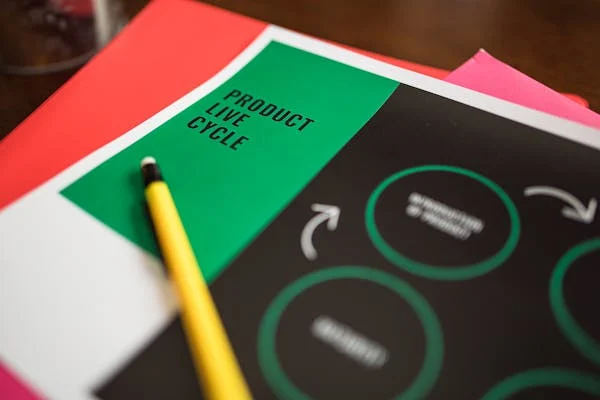Sales teams often have good conversations with leads but struggle to close deals. One major reason? The content they use isn’t doing the heavy lifting. Sales enablement content can be the deal closer — or the deal breaker. In this guide, we break down 30 powerful stats to show what kind of sales content actually converts. And for each one, we break it down into tactical, real-world advice that you can use right away.
1. 95% of B2B buyers choose a vendor that provides relevant content at each stage of the buying process
Why relevance wins deals
Buyers today do their homework. They don’t just want product specs — they want helpful, informative content that speaks directly to their challenges at every step of their journey.
Early in the funnel, they’re asking, “Why should I care about this problem?” Midway, it’s “How does this solution compare to others?” Late in the process, it’s “Why should I trust this vendor?”
If you only show up with content that pushes your product, you’re missing the mark.
What to do about it
The fix is to map your content to the stages of the buyer’s journey:
- Top of funnel: educational blogs, industry trends, problem breakdowns
- Middle of funnel: comparison sheets, case studies, testimonials
- Bottom of funnel: ROI calculators, pricing breakdowns, vendor scorecards
But don’t just create content. Train your sales team to know when to use it. Build a content matrix that shows what content fits which sales stage. Review it with your reps monthly. That simple habit builds muscle memory — and better timing.
2. 76% of sales reps say they can’t find the content they need when they need it
Hidden content is wasted content
Your marketing team might be producing great materials. But if your reps can’t find it quickly, they’ll either use old assets or create their own — often off-brand or out-of-date.
Salespeople work under pressure. When a hot lead asks a question, they don’t have time to dig through five folders or ping marketing.
What to do about it
Centralize all sales content in one easy-to-navigate place. Use tags like “industry,” “sales stage,” and “buyer role” to make it searchable.
Use a simple content enablement tool (even Google Drive works if organized well). Train your team on how to use it. Make it part of onboarding.
Add a short weekly reminder: “This week’s featured content” — just one piece. Over time, it reinforces awareness. If you want reps to use content, you have to market it to them too.
3. Companies with effective sales enablement content see 23% higher lead conversion rates
Conversion starts with content quality
This stat proves content isn’t fluff — it’s fuel. A strong case study or tailored email template can be the difference between a deal moving forward or stalling out.
Effective sales content doesn’t just inform — it influences. It helps a buyer say, “Yes, this is what I need.”
What to do about it
Focus on quality, not volume. Don’t aim to create a hundred pieces. Instead, create a few core ones that hit hard.
Review content monthly: What’s being used? What’s converting? Use CRM feedback and rep input.
Then, revise or replace what isn’t landing. High-converting content has one thing in common: it feels like it was written for that buyer, in that moment. Get closer to that ideal, and you’ll see the lift in conversions.
4. 87% of top-performing sales teams collaborate with marketing to produce content
Teamwork makes the content work
If sales and marketing don’t talk, the content suffers. Sales knows what questions buyers are asking. Marketing knows how to package answers that resonate.
When the two teams work together, they create content that’s both useful and beautiful.
What to do about it
Hold a 30-minute monthly alignment meeting between sales and marketing. Agenda:
- What content worked last month?
- What questions are buyers asking now?
- What’s missing in the content library?
Assign ownership to marketing but keep sales involved in the feedback loop. When reps contribute, they feel more invested — and more likely to use the end result.
5. Sales enablement content boosts win rates by up to 27% when tailored to buyer personas
One-size-fits-all doesn’t win
Buyers want to feel understood. That’s hard to do if your case studies, messaging, and emails all sound generic.
Persona-based content talks the buyer’s language. It addresses their pain points directly and shows that you’ve solved similar problems before.
What to do about it
Build mini content packs for each buyer persona. For example:
- For a CFO: ROI deck, cost breakdown, financial case study
- For a CTO: integration guide, security overview, technical FAQ
- For a marketing director: performance benchmarks, user adoption stats
Equip your reps with these packs. Let them choose based on the stakeholder they’re talking to. Personal relevance drives decision confidence — and conversions.
6. 70% of B2B content goes unused by sales teams
If it’s not used, it’s not useful
This stat hurts. Imagine spending all that time creating blogs, decks, and case studies — and most of it never sees the light of day.
The reason? Content might be off-target, hard to find, or not adapted for sales conversations.
What to do about it
Audit your content library. Ask your sales team to tag each piece as “use often,” “sometimes,” or “never.”
Next, sit down with a few reps and go deeper: why don’t they use certain content? Is it too long? Too general? Hard to personalize?
Then, streamline. Cut or rewrite what’s not working. Put high-performing pieces front and center in your content hub. And when you create something new, always test it with sales first.
7. 65% of buyers say vendor content influenced their final purchase decision
Content carries weight at the finish line
Buyers may not always respond immediately to a piece of content, but they do remember it. Especially if it helps them justify a decision to their team.
Good content gives buyers the language, logic, and confidence to say yes.
What to do about it
Think about the content buyers will forward to their team or boss. Create decision-stage tools like:
- 1-pagers on ROI
- Deployment timelines
- Internal pitch decks they can present to stakeholders
Make content not just for the buyer — but for the buyer’s internal conversations. Help them sell the deal internally, and you’ll close more deals externally.
8. Interactive content increases engagement by 52% compared to static content
Give them something to play with
Static PDFs are fine. But interactive content — like calculators, assessments, or configurators — gets prospects to lean in.
It turns your sales pitch into a two-way experience.
What to do about it
Start simple. Build a pricing calculator or a “fit assessment” tool. Use Typeform, Outgrow, or custom web forms.
Train reps to use these tools live during calls. It makes the conversation more dynamic. And follow up by sending the results in a personalized email.
Interactive content doesn’t just inform — it involves. That’s where real engagement begins.
9. Personalized sales content results in 6x higher conversion rates
Make it feel like it was made just for them
Buyers don’t want a brochure. They want a message that speaks directly to them — their company, their challenges, their goals.
Personalized content feels thoughtful. And thoughtful always stands out.
What to do about it
Help your reps personalize quickly. Give them modular templates they can tweak fast — like editable case study decks or short intro videos.
Use merge fields for name, company, and industry. But go beyond that. Reference specific goals, challenges, or market shifts.
And make it visual. A slide with the buyer’s logo or a graph using their numbers creates an instant emotional lift.
10. 60% of salespeople report that customized case studies are their most effective content asset
Proof sells better than promise
When a buyer sees a real-world result — from someone just like them — it builds trust faster than any product sheet ever could.
Case studies make outcomes tangible.
What to do about it
Create a bank of short, punchy case studies. Format: problem, solution, result — one page max.
Tag them by industry, size, and buyer role. That way, your reps can quickly grab the most relevant one.
Better yet, build a slide deck with one slide per customer win. Let reps pull and rearrange as needed. This kind of mix-and-match content is gold.
11. Video-based enablement content improves retention by 83%
What they watch, they remember
People forget what they read. But they remember what they see and hear — especially if it’s short, helpful, and clear.
Video makes complex ideas simple. And it sticks in the mind.
What to do about it
Record 2–3 minute explainer videos for your key content pieces. Use Loom or Vidyard. Have a salesperson narrate over slides or product demos.
Keep it casual but clear. No scripts needed — just real explanations.
Host videos in your content hub and link to them in sales emails. Buyers will thank you for the clarity — and reps will love having another tool in their kit.
12. Organizations with a formal sales enablement process experience 18% higher revenue attainment
Structure drives results
Ad-hoc sales support doesn’t scale. Reps need consistent systems, tools, and messaging.
Sales enablement isn’t just a toolkit — it’s a framework that ensures every rep is equipped to succeed.
What to do about it
Create a simple enablement playbook. It should include:
- Key buyer personas
- Messaging frameworks
- Asset libraries
- Objection-handling guides
- Competitive insights
Make it a living document. Update monthly. Keep it short and easy to navigate. Reps won’t read a 100-page PDF, but they’ll love a simple Notion or Google Doc that answers their questions fast.
13. 78% of decision-makers find case studies more trustworthy than product brochures
Trust comes from results, not claims
Decision-makers get pitched all the time. They’ve seen enough shiny marketing to know that most brochures say the same thing.
But a case study? That’s a story with real people, real problems, and real results. It doesn’t just claim value — it proves it.
What to do about it
When you build case studies, focus on outcome. Don’t just describe what the customer did. Show the before and after. What improved? How fast? By how much?
Use quotes if possible. Let the customer speak in their own words.
And don’t make it a long read. One to two pages is enough. Busy executives don’t have time for a novel. Give them the key wins, then make it easy for your reps to plug it into conversations or emails.
14. Content aligned with sales stages leads to a 31% shorter sales cycle
The right content at the right time saves time
If a buyer is just learning about the problem, a pricing sheet won’t help. And if they’re ready to decide, a blog post won’t push them forward.
That’s why timing is everything in sales content.

What to do about it
Map each piece of content to a sales stage:
- Awareness: blogs, reports, educational webinars
- Consideration: comparisons, case studies, checklists
- Decision: ROI tools, buyer’s guides, contracts
Create a cheat sheet for your reps. Something they can glance at before a call to pick the best content based on where the buyer is.
When reps can match content to intent, deals move faster.
15. Reps spend an average of 440 hours annually searching for or creating content
That’s 11 full workweeks wasted
This stat should worry every sales leader. Time spent searching is time not selling. And when reps have to create their own materials, you end up with brand inconsistency and weaker messaging.
What to do about it
Build a simple search-and-send system. It could be as easy as a shared folder or a searchable dashboard.
Use clear naming. Tag by persona, topic, and funnel stage.
Better yet, embed content in your CRM. When a rep is logging a deal, they should see recommended assets pop up automatically.
Saving even 30 minutes a week per rep adds up. And more time selling means more revenue.
16. 55% of buyers say consistent messaging across touchpoints increases trust
Mixed messages create doubt
If your email says one thing, your website says another, and your sales deck says something else entirely — buyers notice. And it shakes their confidence.
Consistency is the foundation of trust.
What to do about it
Align your messaging from the start. Create one core narrative — the key story that runs through every piece of content.
Document your brand promise, differentiators, and key proof points. Use the same words across decks, site copy, emails, and calls.
And review it quarterly. As your product or market changes, your message should evolve too — but together, not in silos.
17. Using ROI calculators in sales content boosts conversion by 38%
Show them the money
Buyers don’t just want features — they want results. A simple ROI calculator helps them visualize value in a way that’s clear, fast, and personal.
It moves the conversation from “Is this a good product?” to “Can we afford not to buy this?”
What to do about it
Build a calculator based on real customer outcomes. Let reps plug in buyer-specific numbers during calls — or share a link for buyers to use on their own.
Keep it simple: inputs (costs, time saved, revenue gained), and outputs (ROI, break-even, payback time).
Send the results in a follow-up email. It reinforces the value and gives the buyer something tangible to share with internal stakeholders.
18. Only 35% of companies audit their sales content annually
Outdated content is dangerous content
If your case studies talk about features you no longer offer — or your decks use old branding — it weakens your credibility.
Buyers expect you to be current. If your materials aren’t, it signals that maybe your product or service isn’t either.
What to do about it
Set a quarterly review schedule. Assign one person — usually someone in marketing or enablement — to own it.
Review usage stats, check for brand alignment, update facts and figures, and remove anything stale.
And involve your reps. Ask what they’ve stopped using and why. You’ll surface issues faster — and make smarter decisions about what to retire or refresh.
19. Content shared within the first 48 hours of inquiry sees 40% higher response rates
Timing makes content more powerful
When a lead shows interest, that’s your window. Every hour that passes, their curiosity cools.
If you wait too long to send the right content, you lose momentum — and maybe the deal.
What to do about it
Create pre-packaged follow-up kits. As soon as a lead comes in, reps should have a ready-to-go email template with:

- One educational piece (like a blog)
- One proof piece (like a case study)
- One action piece (like a demo invite or ROI tool)
Automate it if possible. Use your CRM or email tool to trigger the sequence.
The key is speed. Fast follow-ups feel attentive — and relevant content makes them effective.
20. 91% of sales reps believe content quality directly impacts closing rates
Good content is a closer’s best friend
Reps know that a well-placed deck, guide, or case study can be the nudge a buyer needs.
When content is polished, clear, and persuasive, it lifts the whole sales process.
What to do about it
Train reps to give feedback. After big deals — won or lost — ask: did content help? If not, what was missing?
Then act on it. Use those insights to improve your assets.
And don’t just focus on design. Quality means clarity, relevance, and value. Make sure your content isn’t just pretty — it should say something worth hearing.
21. 50% of sales enablement teams report that playbooks increase quota attainment
Playbooks make good reps great
A well-written playbook helps reps stay focused and consistent. It gives them clear direction on how to pitch, what to share, and when to share it.
When everyone is using the same tools and language, performance improves across the board.
What to do about it
Keep your playbooks short and simple. Focus on:
- Key buyer personas and how to speak to them
- Most useful assets by stage
- Top objections and responses
- Questions to ask at each stage
Host it in an easy-to-access place. Google Docs or Notion works well. Update it regularly and treat it as a living, breathing guide.
And here’s the key: make it practical. Avoid theory. Use real examples from top reps. The more grounded your playbook is, the more it’ll actually get used.
22. Long-form whitepapers convert 22% less than short-form one-pagers in mid-funnel conversations
Brevity builds momentum
Buyers in the middle of the funnel don’t want a deep dive — they want quick clarity. They’re trying to evaluate options fast and efficiently.
A long whitepaper can feel like homework. A sharp one-pager gets read, remembered, and forwarded.

What to do about it
Create one-pagers for key use cases, industries, and objections. Each should:
- State the problem
- Show how you solve it
- Share proof in one clear stat or quote
Use simple design. Think bullet points, not paragraphs. Visuals over text blocks.
Train your reps to use them as leave-behinds. Send one after a call as a follow-up. They’re easy to skim — and hard to ignore.
23. 67% of salespeople say email templates with embedded assets improve outreach effectiveness
Smart templates save time and boost impact
Salespeople send a lot of emails. The challenge is crafting messages that feel personal, yet still scale.
Templates with embedded content — like videos, links, or case studies — help reps deliver value quickly.
What to do about it
Build a library of outreach templates. Include different types:
- First-touch emails
- Follow-ups
- Re-engagement messages
For each, add a recommended asset — something useful and relevant to the buyer’s stage.
Keep the tone conversational. And give reps room to personalize. A great template isn’t a script — it’s a solid starting point.
24. Pitch decks with visuals see 30% higher buyer engagement
A picture sells better than a paragraph
No one wants to flip through a wall of text. Visuals break up the page, clarify your message, and stick in the buyer’s mind.
Especially in pitch decks, visuals make you look sharper and more confident.
What to do about it
Upgrade your sales deck with clean, modern visuals. Use icons, charts, and product screenshots.
Replace text-heavy slides with diagrams that show how your solution works. Use data visualizations to make proof points pop.
Keep slides uncluttered. One idea per slide. Clear flow from start to finish. If it feels easy to follow, buyers will stick with you longer.
25. Content repurposed from webinars leads to 2x more qualified leads
Your webinars are a goldmine
You spend a lot of time planning and running webinars. Don’t let the value end when the event does.
Webinars are full of questions, insights, and real buyer language. That’s exactly what makes great sales content.

What to do about it
After each webinar, break it into:
- A short recap blog
- 2–3 short video clips for follow-ups
- A one-page takeaway sheet
- Email snippets with timestamps (“jump to this moment”)
Use these in mid-funnel nurturing. Send clips to buyers who ask similar questions. Reps love having this kind of content in their back pocket.
It’s fresh, relevant, and already proven to engage.
26. Infographics shared in follow-up emails increase click-through rates by 25%
Visual summaries catch the eye
When a buyer gets a follow-up email, they’re skimming. A good infographic stops the scroll. It delivers value at a glance.
That’s especially powerful after a call or demo.
What to do about it
Build a few infographics that summarize key ideas: ROI breakdowns, process overviews, comparison grids.
Keep them short — one screen’s worth. Make sure they work well on mobile.
Train reps to include them in follow-ups. Just a quick line like, “Here’s a quick visual of what we covered” adds polish to the conversation.
It looks professional, feels helpful, and earns more clicks.
27. Real-time content analytics increase sales performance by 24%
Data beats guesswork
When you know which content is being opened, shared, or ignored — you can make smarter decisions.
Reps can follow up faster. Marketers can improve what they produce. Everyone wins.

What to do about it
Use content tools with analytics — like DocSend, Seismic, or Highspot. They show who viewed what, for how long, and when.
Set alerts for when a buyer opens a deck. That’s your moment to follow up.
Review performance monthly. Cut the bottom 10% of assets. Double down on the top 10%. Let real data guide your enablement strategy.
28. Battle cards used in 1-on-1 selling drive a 14% lift in deal velocity
Confidence closes faster
When reps know exactly how to position against competitors, they stay in control. They don’t get rattled. And they keep the conversation focused.
Battle cards give reps that edge.
What to do about it
Create short, focused battle cards for your top 3–5 competitors. For each one:
- Key differentiators
- Weak points (without badmouthing)
- Suggested talk tracks
- Objection responses
Make them one-pagers. Store them in your content hub. And train reps to use them live during calls — not just in prep.
A confident response beats a defensive one. Battle cards help make that happen.
29. Companies with centralized content hubs see a 43% increase in usage
Convenience drives adoption
If your content is scattered across email threads, folders, and Slack messages — reps won’t use it. Even if it’s great.
A single hub makes it easy to find, trust, and share.
What to do about it
Pick one platform. Doesn’t matter if it’s fancy. Google Drive, Notion, SharePoint — all can work if organized well.
Use folders or tags for:
- Content by buyer stage
- Content by industry
- Content by persona
Add a search bar and preview links. Send a short weekly update highlighting what’s new.
Reps love tools that save time. A good content hub does just that.
30. 84% of B2B buyers say they’re more likely to buy from vendors who clearly communicate value through content
Clarity wins trust
Buyers don’t want to work hard to understand your value. If your content makes the benefits crystal clear — they feel confident in you.
Confidence leads to action.
What to do about it
Rewrite your core assets with a focus on clarity. Each piece should answer: What’s in it for the buyer?
Avoid jargon. Use short sentences. Focus on outcomes, not features.

Test your content with real users. If they can’t explain the value after 30 seconds, it’s time to revise.
Simple, clear, and focused content does more than educate — it earns the win.
Conclusion
Sales enablement content is no longer optional — it’s essential. The right content, used at the right time, by a well-prepared rep, can move deals faster, increase trust, and boost conversion rates across the board.
What these 30 stats prove is simple: content isn’t just a support function. It’s a growth driver. But only when it’s built intentionally, delivered strategically, and constantly improved through real feedback and analytics.





















